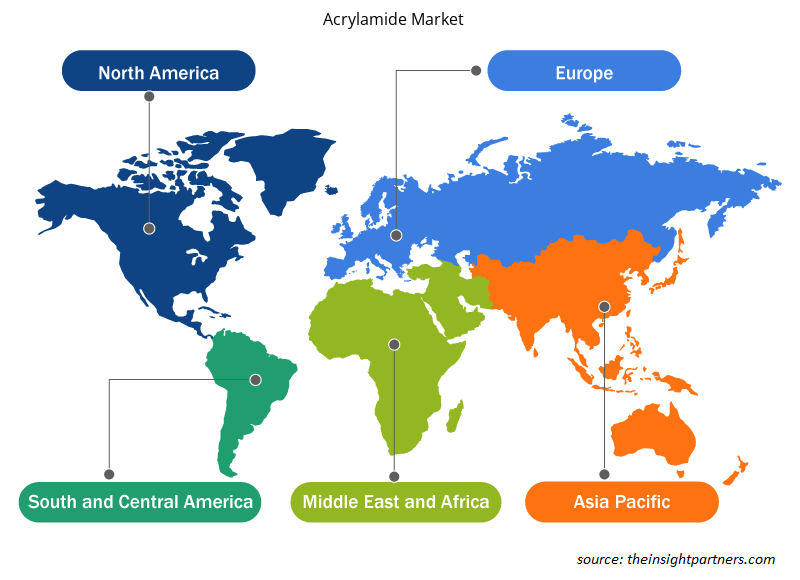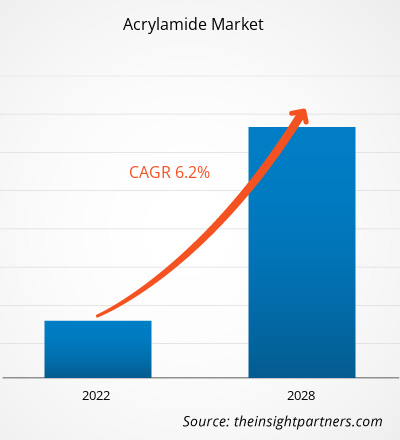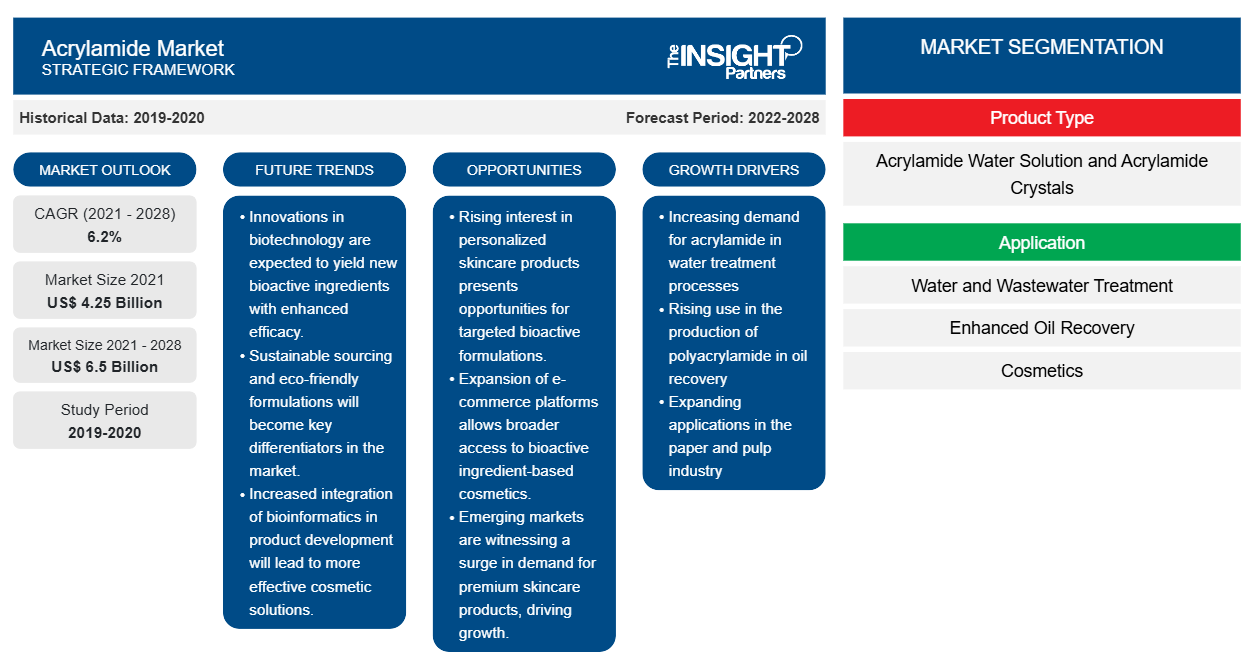Si prevede che il mercato dell'acrilamide crescerà da 4.254,16 milioni di dollari nel 2021 a 6.500,22 milioni di dollari entro il 2028; si stima che crescerà a un CAGR del 6,2% dal 2021 al 2028.
L'acrilamide è una sostanza chimica organica e inodore disponibile in forma liquida e cristallina. L'acrilamide è solubile in acqua e in vari solventi organici. È un precursore delle poliacrilammidi che hanno diverse applicazioni come addensanti idrosolubili e agenti di flocculazione.
Nel 2020, l'Asia Pacifica ha dominato il mercato globale dell'acrilamide e si prevede che manterrà il suo predominio durante il periodo di previsione. Giappone e Cina sono i principali produttori di acrilammide, rappresentando una parte significativa della capacità installata globale. Il crescente sostegno governativo al trattamento delle acque reflue in paesi come India e Cina e la crescente industria cosmetica e della cura della persona nella regione stanno guidando la crescita del mercato nell'Asia Pacifica. L'industria della cura della persona nella regione sta crescendo a causa dell'aumento della popolazione a medio reddito, dell'aumento del reddito pro capite, del miglioramento degli standard di vita e di un aumento della popolazione femminile lavoratrice. Pertanto, la crescente industria della cura della persona ha portato a una crescente domanda di acrilammide, poiché è ampiamente utilizzata come stabilizzante, legante e addensante nei cosmetici e nei prodotti per la cura della persona. Insieme a questo, si prevede che il Nord America sarà la seconda regione in più rapida crescita, che è dovuta all'aumento degli investimenti nel trattamento delle acque reflue e a un aumento della domanda di acrilammide dal settore del recupero avanzato del petrolio e dei cosmetici. Si prevede che anche l'Europa assisterà a una crescita considerevole durante il periodo di previsione.
Personalizza questo report in base alle tue esigenze
Riceverai la personalizzazione gratuita di qualsiasi report, comprese parti di questo report, o analisi a livello nazionale, pacchetto dati Excel, oltre a usufruire di grandi offerte e sconti per start-up e università
-
Scopri le principali tendenze di mercato in questo rapporto.Questo campione GRATUITO includerà analisi di dati che spaziano dalle tendenze di mercato alle stime e alle previsioni.
Approfondimenti di mercato
Crescente domanda di trattamento delle acque reflue
La forte crescita economica, la crescita demografica e la rapida urbanizzazione in tutto il mondo hanno portato a un aumento del consumo di acqua potabile e della produzione di acque reflue. Vari paesi hanno imposto norme severe contro l'inquinamento dei corpi idrici e lo scarico illegale di acque reflue. In paesi come la Cina, che è colpita dall'inquinamento atmosferico, sono state implementate leggi speciali per proteggerla dall'impatto dannoso dello scarico di acque reflue. La gestione delle acque reflue industriali è diventata una preoccupazione cruciale tra gli enti normativi, poiché gli effluenti industriali includono sostanze chimiche nocive, che possono portare a rischi per la salute e ostacolare la biodiversità marina. Pertanto, l'aumento della domanda di trattamento delle acque reflue in tutto il mondo sta guidando la crescita del mercato.
Informazioni sul tipo di prodotto
In base al tipo di prodotto, il mercato è diviso in soluzioni acquose di acrilammide e cristalli di acrilammide. Nel 2020, il segmento dei cristalli di acrilammide è stato il segmento in più rapida crescita nel mercato dell'acrilamide. I cristalli di acrilammide hanno varie applicazioni e sono utilizzati come flocculante, agente bloccante, agente di trattamento tessile e agente di trattamento delle acque.flocculant, blocking agent, textile treatment agent, and water treatment agent.
Ashland Global Holding Inc.; SNF; Kemira OYJ; BASF SE; EMCO Dyestuff; Mitsui Chemicals Global, Pvt. Ltd.; Ineos AG; Solvay; Nuoer Group; e Black Rose Industries Ltd.; sono tra i principali attori che operano nel mercato globale. I principali attori adottano diverse strategie, come fusioni e acquisizioni e lanci di prodotti, per espandere la loro presenza geografica e la base di consumatori.
Approfondimenti regionali sul mercato dell'acrilamide
Le tendenze regionali e i fattori che influenzano il mercato dell'acrilamide durante il periodo di previsione sono stati ampiamente spiegati dagli analisti di Insight Partners. Questa sezione discute anche i segmenti e la geografia del mercato dell'acrilamide in Nord America, Europa, Asia Pacifico, Medio Oriente e Africa e Sud e Centro America.

- Ottieni i dati specifici regionali per il mercato dell'acrilamide
Ambito del rapporto sul mercato dell'acrilamide
| Attributo del report | Dettagli |
|---|---|
| Dimensioni del mercato nel 2021 | 4,25 miliardi di dollari USA |
| Dimensioni del mercato entro il 2028 | 6,5 miliardi di dollari USA |
| CAGR globale (2021 - 2028) | 6,2% |
| Dati storici | 2019-2020 |
| Periodo di previsione | 2022-2028 |
| Segmenti coperti |
Per tipo di prodotto
|
| Regioni e Paesi coperti |
America del Nord
|
| Leader di mercato e profili aziendali chiave |
|
Densità degli attori del mercato dell'acrilamide: comprendere il suo impatto sulle dinamiche aziendali
Il mercato dell'acrilamide sta crescendo rapidamente, spinto dalla crescente domanda degli utenti finali dovuta a fattori quali l'evoluzione delle preferenze dei consumatori, i progressi tecnologici e una maggiore consapevolezza dei benefici del prodotto. Con l'aumento della domanda, le aziende stanno ampliando le loro offerte, innovando per soddisfare le esigenze dei consumatori e capitalizzando sulle tendenze emergenti, il che alimenta ulteriormente la crescita del mercato.
La densità degli operatori di mercato si riferisce alla distribuzione di aziende o società che operano in un particolare mercato o settore. Indica quanti concorrenti (operatori di mercato) sono presenti in un dato spazio di mercato in relazione alle sue dimensioni o al valore di mercato totale.
Le principali aziende che operano nel mercato dell'acrilamide sono:
- INEOS Styrolution Italia S.p.A.
- Società quotata in borsa Ashland Global Holdings Inc.
- SNF
- Kemira Oyj
- BASF SE
Disclaimer : le aziende elencate sopra non sono classificate secondo un ordine particolare.

- Ottieni una panoramica dei principali attori del mercato dell'acrilamide
Segnala i riflettori
- Tendenze progressive nel settore dell'acrilamide per aiutare gli operatori a sviluppare strategie efficaci a lungo termine
- Strategie di crescita aziendale adottate dalle aziende per garantire la crescita nei mercati sviluppati e in via di sviluppo
- Analisi quantitativa del mercato globale dell'acrilamide dal 2019 al 2028
- Stima della domanda di acrilammide in vari settori industriali
- Analisi di Porter per illustrare l'efficacia degli acquirenti e dei fornitori che operano nel settore per prevedere la crescita del mercato
- Sviluppi recenti per comprendere lo scenario competitivo del mercato e la domanda di acrilammide
- Tendenze e prospettive del mercato, insieme ai fattori che guidano e frenano la crescita del mercato dell'acrilamide
- Comprensione delle strategie che sostengono l'interesse commerciale in relazione alla crescita del mercato globale dell'acrilamide, aiutando nel processo decisionale
- Dimensioni del mercato dell'acrilamide in vari nodi del mercato
- Panoramica dettagliata e segmentazione del mercato globale dell'acrilamide nonché delle sue dinamiche industriali
- Dimensioni del mercato dell'acrilamide in varie regioni con promettenti opportunità di crescita
"Global Acrylamide Market Analysis to 2028" è uno studio specializzato e approfondito del settore chimico e dei materiali, incentrato sull'analisi delle tendenze del mercato globale dell'acrilamide. Il rapporto mira a fornire una panoramica del mercato con una segmentazione dettagliata del mercato. Il mercato dell'acrilamide è segmentato in base al tipo di prodotto, all'applicazione e alla geografia. In base al tipo di prodotto, il mercato è suddiviso in soluzione acquosa di acrilammide e cristalli di acrilammide. In base all'applicazione, il mercato è suddiviso in trattamento delle acque e delle acque reflue, recupero avanzato di petrolio , cosmetici, produzione di carta, intermedi chimici, tessili e altri. In base alla geografia, il mercato è suddiviso in cinque regioni principali: Nord America, Europa, Asia Pacifico, Medio Oriente e Africa e Sud e Centro America. L'acrilamide è utilizzata per produrre polimeri di acrilammide (poliacrilamide) che vengono utilizzati come flocculanti nel trattamento delle acque reflue. Coagula la materia organica che può essere rimossa tramite filtrazione. Il crescente sviluppo di impianti di trattamento delle acque reflue in tutto il mondo sta incrementando la domanda di acrilammide.
Profili aziendali
- Società per azioni Ashland Global Holding Inc.
- SNF
- Kemira OYJ
- BASF SE
- Colorante EMCO
- Azienda produttrice di prodotti chimici Mitsui.
- Ineos AG
- Solvay
- Gruppo Nuoer
- Società anonima Black Rose Industries Ltd.;
- Analisi storica (2 anni), anno base, previsione (7 anni) con CAGR
- Analisi PEST e SWOT
- Valore/volume delle dimensioni del mercato - Globale, Regionale, Nazionale
- Industria e panorama competitivo
- Set di dati Excel
Report recenti
Testimonianze
Motivo dell'acquisto
- Processo decisionale informato
- Comprensione delle dinamiche di mercato
- Analisi competitiva
- Analisi dei clienti
- Previsioni di mercato
- Mitigazione del rischio
- Pianificazione strategica
- Giustificazione degli investimenti
- Identificazione dei mercati emergenti
- Miglioramento delle strategie di marketing
- Aumento dell'efficienza operativa
- Allineamento alle tendenze normative























 Ottieni un campione gratuito per - Mercato dell'acrilammide
Ottieni un campione gratuito per - Mercato dell'acrilammide